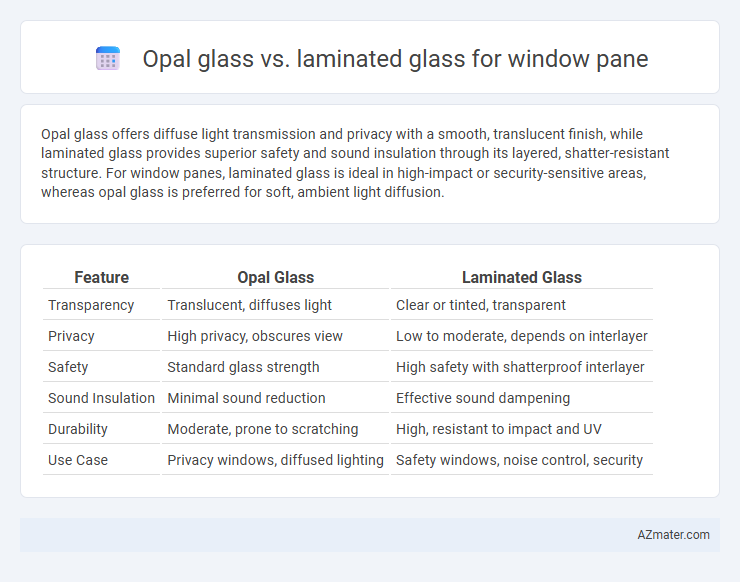Opal glass offers diffuse light transmission and privacy with a smooth, translucent finish, while laminated glass provides superior safety and sound insulation through its layered, shatter-resistant structure. For window panes, laminated glass is ideal in high-impact or security-sensitive areas, whereas opal glass is preferred for soft, ambient light diffusion.
Table of Comparison
| Feature | Opal Glass | Laminated Glass |
|---|---|---|
| Transparency | Translucent, diffuses light | Clear or tinted, transparent |
| Privacy | High privacy, obscures view | Low to moderate, depends on interlayer |
| Safety | Standard glass strength | High safety with shatterproof interlayer |
| Sound Insulation | Minimal sound reduction | Effective sound dampening |
| Durability | Moderate, prone to scratching | High, resistant to impact and UV |
| Use Case | Privacy windows, diffused lighting | Safety windows, noise control, security |
Introduction to Opal Glass and Laminated Glass
Opal glass is a type of frosted or milky glass designed to diffuse light evenly, providing privacy while maintaining brightness in window panes. Laminated glass consists of two or more layers of glass bonded with an interlayer, usually polyvinyl butyral (PVB), which enhances safety by preventing shattering upon impact. Both materials are widely used in architectural windows, with opal glass favored for aesthetic diffusion and laminated glass preferred for security and sound insulation.
Composition and Manufacturing Process
Opal glass is composed of silica mixed with various metal oxides to create a translucent, milky appearance, produced through a melting and casting process that ensures uniform opacity. Laminated glass consists of two or more layers of glass bonded with an interlayer, typically polyvinyl butyral (PVB), created by heat and pressure lamination to enhance strength and safety. The manufacturing of laminated glass involves precise lamination techniques to retain transparency while improving impact resistance, whereas opal glass emphasizes consistent diffusion of light through its unique material composition.
Visual Appearance and Aesthetics
Opal glass offers a smooth, evenly diffused light effect that enhances privacy while maintaining a soft, elegant appearance ideal for modern interiors. Laminated glass combines clarity with safety features, providing a transparent look that preserves views and adds a glossy finish to window panes. While opal glass emphasizes matte diffusion for subtle aesthetics, laminated glass highlights sleekness and durability, catering to different design preferences.
Light Transmission and Privacy
Opal glass offers diffused light transmission, creating a soft, even glow while enhancing privacy due to its opaque finish that obscures visibility. Laminated glass provides clear visibility with high light transmission but can incorporate frosted or silk-screened layers to increase privacy without significantly reducing natural light. Choosing between opal and laminated glass depends on balancing the need for maximum light diffusion and privacy levels in window pane applications.
Strength and Durability Comparison
Opal glass offers moderate strength with a focus on aesthetic diffusion and privacy, making it less impact-resistant than laminated glass. Laminated glass consists of multiple layers bonded with a plastic interlayer, providing superior strength, shatter resistance, and enhanced durability against impacts and forced entry. For window panes requiring maximum safety and long-term performance, laminated glass is the preferred option due to its higher structural integrity and resilience.
Safety Features and Security
Opal glass offers enhanced privacy and diffuses light while maintaining moderate impact resistance, making it less effective against forced entry compared to laminated glass. Laminated glass consists of two or more glass layers bonded with an interlayer that holds shards together upon impact, significantly improving safety by preventing glass from shattering and enhancing security against break-ins. The interlayer in laminated glass also provides superior resistance to penetration, making it a preferred choice for high-security window applications.
Energy Efficiency and Insulation
Opal glass offers superior light diffusion, reducing glare while maintaining privacy, but provides moderate thermal insulation compared to laminated glass. Laminated glass consists of multiple layers with a polyvinyl butyral (PVB) interlayer, enhancing energy efficiency by reducing heat transfer and improving sound insulation. For maximizing window pane energy performance, laminated glass typically delivers better insulation properties to lower heating and cooling costs.
Maintenance and Longevity
Opal glass offers a smooth, matte finish that resists minor scratches and fingerprints, making maintenance straightforward with just regular cleaning using mild detergents. Laminated glass, consisting of two glass layers bonded with a plastic interlayer, provides enhanced durability and crack resistance, significantly extending its lifespan under harsh weather conditions. While laminated glass requires occasional inspection of the interlayer for discoloration or delamination, its robust construction generally ensures superior longevity compared to opal glass in windowpane applications.
Cost Comparison: Opal vs Laminated Glass
Opal glass typically costs more than laminated glass due to its unique translucent aesthetic and specialized manufacturing process. Laminated glass offers a more budget-friendly option while providing enhanced safety with its multiple layers and interlayer film. Choosing between opal and laminated glass depends on balancing aesthetic preference with cost-efficiency and security needs.
Ideal Applications for Window Panes
Opal glass is ideal for window panes requiring diffused natural light and enhanced privacy in residential bathrooms or office partitions without sacrificing brightness. Laminated glass offers superior safety and security benefits, making it suitable for high-risk areas such as storefronts, schools, and ground-level windows where impact resistance and shatter retention are critical. Both materials improve energy efficiency, but laminated glass also provides better sound insulation, ideal for urban environments.

Infographic: Opal glass vs Laminated glass for Window pane
 azmater.com
azmater.com